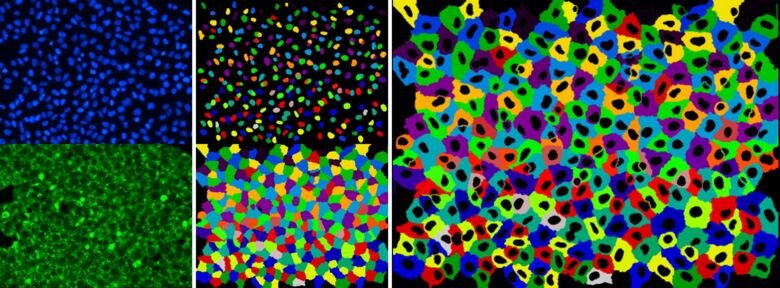Image Processing and Analysis at BIC
As a BIC user, you have access to workstations equipped with diverse image analysis software, including both licensed and free-ware products. These tools support image processing, intensity measurements, object counting, and the creation of movies and 3D models. The workstations are conveniently situated next to the microscopes at BIC2.

Image analysis tools
All workstations are equipped with the vendor’s ‘lite’ versions of the acquisition software (Zeiss Zen Lite, Olympus Micro, LAS X Lite, NIS Element Viewer, IncuCyte), along with the basic analysis tools (ImageJ/Fiji, MATLAB, CellProfiler, and QuPath). Additionally, licensed software such as Imaris, Amira, AutoQuant, and NisElements is available. If you require specialized software for your analysis, it can be installed upon request.
Workstations at the BIC facility
All workstations are free to use for BIC users but need a reservation in iLab. The working stations can be accessed remotely via the VNC Viewer, ask the BIC facility staff for the access instructions. OBS! Do not turn workstations off when finished, only log out of the BIC user account.
Workstation 3 (Imaris)
WS3 features Imaris, Anaconda/Python and KNME Analytics in addition to the ‘lite’ versions of the software and basic analysis tools.
Workstation 4 (NIS Elements)
WS4 has NIS Elements (Nikon), FluoView (Olympus) and MERSCOPE visualizer/vpt/cellpose2 (Vizgen) in addition to basic analysis tools.
Workstation 6 (Imaris, AutoQuant deconvolution)
WS6 is a top-notch workstation with Imaris full license, however without the built-in Clearview deconvolution. Instead, it has the AutoQuant deconvolution program, in addition to the ‘lite’ versions of the microscope software and basic analysis tools.
Workstation 7 (full Imaris license with Clearview deconvolution)
WS7 is a powerful analysis station with a full Imaris license including the ClearView deconvolution module. It also features MATLAB and ‘lite’ versions of the microscope system software, plus Fiji, CellProfiler, QuPath, KNME Analytics etc.
Workstation 8
WS8 is dedicated to the big datasets' analysis like obtained by light sheet microscopy. It has installed Amira, Dragonfly and programming software.
BIC ImageClinic
BIC ImageClinics are regular drop-in sessions for both current BIC users and those thinking about using our services. At these sessions, you can discuss with our BIC staff various aspects of microscopy, experimental design, image analysis, presentations, and more. Welcome to drop by with your questions!
- Date: Every other Wednesday, see announcements on upcoming events and activities at BIC
- Time: 09:00-12:00
- Venue: Room C0412, Biomedicum, floor 4
